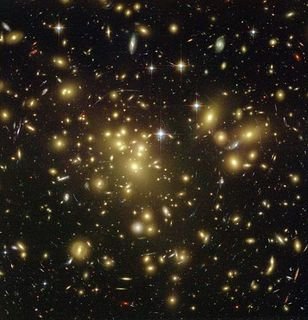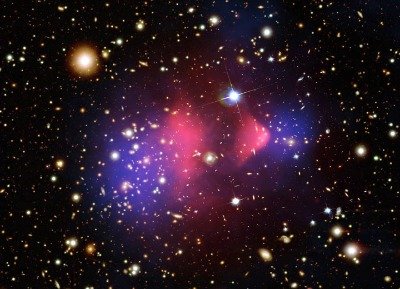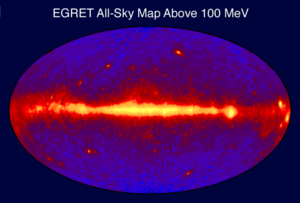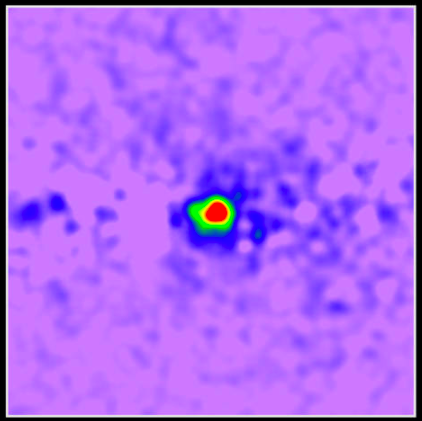Potential dark matter signals from the galactic center
I would like today to come back to the topic of dark matter.
Recently, a couple of puzzling excesses have been observed in cosmological data and physicist are trying to provide explanations.

[image credits: Wikipedia]
The nice features of all those excesses is that they can (kind of) easily be interpreted as signals for dark matter.
Of course, although the dark matter explanation is very appealing, it is today too early for being able to conclude about this explanation being correct or wrong.
I will describe below the excesses I want to talk about and how dark matter could help in re-establishing the agreement between data and theory.
DARK MATTER IN A NUTSHELL
I already wrote long ago about what is dark matter in general (please check here if interested). I will thus only recapitulate a little bit and provide the minimum requirement for the understanding of this post.
Dark matter consists of one of the building blocks of the standard model of cosmology.
This conclusion results from a large amount of phenomena that can be easily explained by the presence of dark matter. We have for instance the rotation curves of the galaxies, cosmic microwave background data or big bang nucleosynthesis.

[image credit: NASA]
We must however keep in mind that even if dark matter is one of the best option, alternatives also exist (like when gravity is modified). Those alternatives are very-well alive and not excluded at all.
In this article, I will however restrict myself to the dark matter hypothesis.
Thus assumes that a large fraction of the matter in the Universe consists of a form of matter that is dark.
This actually means that dark matter is matter-like in the sense that it interacts gravitationally, and it is dark for the reason that it does not interact electromagnetically.
The true nature of dark matter is however unknown. Moreover, as there is no candidate for dark matter in the Standard Model of particle physics, the nature of dark matter is one of the most important issue of cosmology and particle physics.
WHERE TO SEARCH FOR DARK MATTER?
One of the most popular candidate for dark matter is the so-called WIMP candidate, an acronym (yeah again) standing for Weakly-Interacting Massive Particles.
Such particles are very common in many new physics scenarios and their phenomenological consequences in terms of potential signals make them easily searchable in the sky and at colliders.

[image credits: Wikipedia]
In particular, WIMP are expected to indirectly show themselves in gamma rays. An example is shown on the picture of the left where gamma ray sources are depicted.
Although I have already mentioned the mechanism behind such an indirect detection of dark matter in my previous post on the HAWC observatory, let me again recapitulate it a little bit.
One targets regions of the universe that are known to be dense in dark matter. As a result, dark matter particles are very likely to annihilate into Standard Model particles, and in particular into photons (that are gamma rays). We then only need to wait and observe these gamma rays on Earth.
One possible source for these gamma rays consists of dwarf galaxies, and this is the starting points of the search at the HAWC observatory, for instance.
But another very good region of the Universe that is full of dark matter is the center of the Milky Way. There is a strong evidence for the presence of a supermassive back hole there, but the galactic center is also believed to contain a very large amount of dark matter.
This is indeed what comes out of many standard models for dark matter distributions in the galaxy.
GAMMA RAY EXCESS IN THE GALACTIC CENTER
The Fermi-LAT satellite (or NASA's Fermi Gamma-ray Space Telescope) is one of such experiments investigating the properties of the gamma rays. Data from the galactic center is currently exhibiting a slight excess than cannot be explained by standard mechanisms.
Physicists have indeed tried many (standard) hypotheses to explain the excess, ranging from undiscovered pulsars to cosmic ray collisions on gas clouds, but without any success.

[image credits: NASA]
On the image to the right, we observe what is left once all contributions from these standard sources of gamma rays are removed. It is unambiguous. There is something (the green-red spot in the middle of the picture).
Even after considering that the astrophysical noise may have been underestimated, the excess stays. In other words, even when considering the large uncertainties on the results and predictions, there is something in there.
We are therefore left to try explanations based on new phenomena, like, for instance, dark matter.
EXCESSES IN COSMIC RAYS FROM AMS-02
Cosmic rays are also good probes for new phenomena and they are probed within many experiment.

[image credits: Wikipedia]
AMS, whose name stands for the Alpha Magnetic Spectrometer, is one of these. It consists a module mounted on the International Space Station that aims to study the properties of different types of cosmic rays from various energies.
The picture of this device is shown on the left
In 2013, the AMS collaboration released its results and announced an unknown excess in the flux of positrons (the antimatter particle associated with the electron). The scientific article can be found here .
The conclusions are that there is no (standard) way to explain the relative differences observed in the amount of electron and positron cosmic rays and one must rely on something new.
One possible option for this 'something new' could be, once again, dark matter and in particular WIMP annihilation in the galactic center (see here for more information).
DARK MATTER SEMI-ANNIHILATIONS
The reason of this post is that I recently read this article where the authors propose a common explanation for both the above excesses.
The idea is to consider a dark matter candidate that is a WIMP, but that semi-annihilates instead of annihilating. This consists of a process where two dark matter particles annihilate into a new dark matter particle and a Higgs boson or a Z-boson.
They have shown that both mechanisms (the one with the Higgs and the one with the Z-boson) yield setups consistent with data. This means that those models first reproduce the excesses and then allow to escape all existing experimental constraints on dark matter.
Those models however offer the advantage of being less severely constrained by dark matter direct detection experiments, and may thus survive better in the future in the light of future data.
TAKE-HOME MESSAGE AND REFERENCES
In this article, I discussed excesses in cosmology that could be explained by the presence of dark matter. Both the considered excesses originate from the galactic center.
I have depicted a new dark matter semi-annihilation mechanism that has been proposed by some colleagues to explain those excesses.
Some further pieces information can be found in the following publications:
- Information on dark matter and the galactic center can be found here
- Information on gamma ray excesses in the galactic center found by Fermi-LAT can be found here.
- The AMS homepage is here.
- A possible WIMP explanation for the AMS and Fermi-LAT excesses has been detailed in this article.
- A bunch of wikipedia pages are very nice, like this one on dark matter or this one on gamma rays
I have a theory of Dark Matter. Perhaps the Universe has a contraction phase and expansion phase and maybe it happens simultaneously in cycles. During the contraction part, all matter combine so densely that it turns dark, cold and very slow moving. Example: When combining colors, the more colors in the mix the darker it gets. If all colors are combined, it turns black. During expansion, matter, colors seperate causing rapid acceleration, lighter colors, heat, little density. When colors are seperated to the extreme, it turns white. So, maybe Dark matter is extremely condense matter and light is expanded seperated matter.
I am sorry to admit that this makes not very much sense to me... Do you mind trying to write down some equations, maybe. Equations are a kind of universal language after all :)
DM ^ (RGB/CMYK) #000000 > < #ffffff (RGB/CMYK)=😜
😂😂😂
:D
That would be a hypothesis. Nay, scratch that, a showerthought :)
Did someone say "Dark Matter"?
Always! Additionally, the article talks about annihilations. I am sure you will like it!
Here's an explosive thought - A whole lot of dark matter inside a supermassive black hole :)
A dark hole? :D
Well, "black" means "without light", while "dark" means "We don't know shit" :) No one wants to mess with black holes already, but a dark hole sounds ominous!
:D
As always very interesting to read.
Last year there was something in the press about someone who claimed to have come up with some formula, from which he could deduce the laws of Newton and Einstein, but which managed to explain the known universe without the need for dark matter.
Has such a thing actually been discovered, or is it at this time just considered as one of the alternatives, pending further investigation?
Thanks for your comment!
To comment on this I will need more information. Although most alternatives I know about rely on modified gravity setup where one recover Newton in some limits. This may be the same.
To discuss discoveries, for the moment we don't know. Both hypotheses (with or without dark matter) still survive data and are thus well alive. Time will tell us (hopefully).
Not entirely sure, but I believe it was this theory here:
https://en.wikipedia.org/wiki/Entropic_gravity
Ah ok, E. Verlinde's theory. I was not thinking about that one. This theory is being tested, and passed a couple of tests. There are however more to come.
That is all I know about it. I must however admit I haven't read the articles... :)
The semi-annihilates theory is quite convincing in one way, but what kind of process could initiate the annihilation of two dark particles into one that leaves an excess of energy over in the form of a higgs or z-boson particle in intergalactic space. If you have a link to a article about modified gravity that would be great. Thanks.
There are a couple of examples in the article I refer to in the post (you can check it out here).
Concerning modified gravity, please have a look to this workshop where those ideas have been discussed in details. But I am not sure this is what you are looking for: that is not popularized.
Sounds good. Thanks
You're very welcome. Don't hesitate to come back to me if necessary.
This is such a dark topic...lol..brilliant like usual!
Unfortunately, you have to chose between brilliant and dark :D
I met your father in law today via email...lol! I don't know how I put it together but I asked him if he was family of you and he said yes, you are married to his daughter...was quite funny!
How does it come? :D
Sill learning dark matter. but interesting is black whole. love universe related post. nice . upvote and follow!
Thanks a lot!
We can't see it, we can't detect it. It's DARK MATTER!
We can't feel it, we can't detect it. It's DARK ENERGY!
What other darkness lurks in the realm of astrophysics?
that is already dark enough, isn't it? :D
PS: I heard a lot about dark showers (at the LHC) this week.
What the hell are they colliding this time?
Always protons: the particles that collide do not change. Only the hypotheses on the new phenomena that are possibly observable change.
I like it :) very good post :)
Thank you!
you are welcome :)
love it! Very interesting.